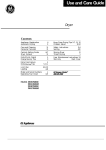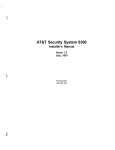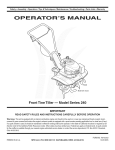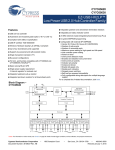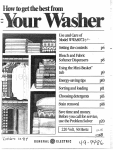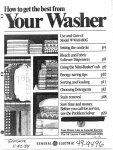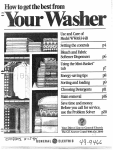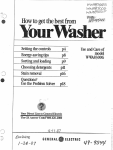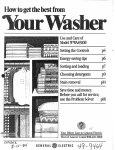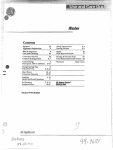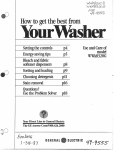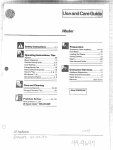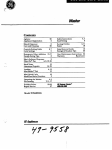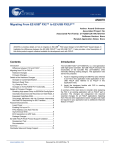Download GE WWA5304V User's Manual
Transcript
b
=
use
and
care
of
Model
WWA5304~
setting
the
controls p4
Ener~-saving
tips
-@3
sorting
andloading
p9
choosing
detergents
.
Stain
removal
Questions?
UsetheProblem
Solver
!pMii
How to operateym.lr
washer
. . . . . . ..’......
. ...4.5
Ckr?trdssettingguide’for
differentfabricsandloads . . ..6.’7
Goodsotiingmeansbetter
washing.......:......’.
. ..’..9
Itpaystocieckand J
‘ ‘:
- ,
pm-treat. . . . . . . . . . . . . . . ...) .9
Howtoloadyot.wwasher. . . ...10
Wbatisti3ebeitsize load ~~
“
of-clothes
. . . . . . . . . . . . . . ..-. .K)’
,..
,..Facto~s
to60nsiderin
“’
$
selectionofdet.ergents
Wldsbap
. .. . . . . . . . . . . . . . . . ..ll
The resultsof
Cmltinue-d
use of
Carbonatedetergents.. . . . . ..’ ..12 ;
EIowmtichdetergentor soap
~‘ “
Shouldyouuse =. . . . . . . . . . . . . 13
Readthis book Ctlrefully.
writedownthemodel
It is intendedto helpyouope~ate
andmaintainyournewwasher
properly.
andserialnunlberse
Keepit handyfor answersto your
questions.
If youdon’tunderstandsomething
or needmorehelp,write(include
yourphonenumber)
ConsumerAffairs
GeneralElectricCompany
AppliancePark
Louisville,KY40225
Eym received.
a
bm~ed washer.
e e
Immediatelycontactthedealer
(or builder)thatsoldyouthe
washer.
saw’timeand money.
Ekfmeyou request
WmAx!.
..
checktheProblemSolveron
pages18-22.It listsminorcauses
of operatingproblemsthatyoucan
correctyourself.
..o....M
other h.mdry pmdwts . . . . . ...15
Howtoremovestains . . . ...16. H
ModelNumber
—
SerialNumber
Howto twe detergentCWscmp.. . . . . . . . . . . . . ..o. .s U
pi
Hard Watcm—cb
haveit . . . . . . . . . . . . . . .
You’llfindthemcma labelonthe
lowerleftsidenearthefront.
Thesenumbersareahsoonthe
ConsumerProductOwnership
RegistrationCardthatcamewith
yourwasher.Beforesendinginthis
card,pleasewritethesenumbers
here:
Usethesenumbersin any
correspondenceor servicecalls
concerningyourwasher.
TOobtainHispanicversionof
thisbook,call
TheGEAnswerCenter”
800.626.2000
consumerinformationservice.
Toll-free.
Paraobtenerlaversi6nen
espaiiolde &temanual,
namegratisa
TheGEAnswerCenter?
serviciodeinformacidn
paraelconsumidor,
telifono800.626.2000.
AllwashinginstructiontermsinthisbookconformtotheCareLabeling
RuleestablishedbytheFederd TradeCommission,January1984. -
The Probhll&3hJer . . . . ...18-22
lJseI- maintenance
instructions
. . . . . . . . . . . . . . ..23
HYlmNeedServi03. . . . . . . . . .23
“Wmwy ... . . . . . . ..l%lckckwer
2
,....
\YA1?NING—lVhenusingthis
appliance,alwaysexercisebasic
safetyprecautions, includingthe
following:
* use this appli%mce
only for its
irHem%x!/
purpose as describedin
thisUse and Care Book.
o This washer must be properly
irls$tilledand hMX3ted
in accordarleewith the Installation Instruetions before it is used. If you did
riotreceivean InstaHationInstructionssheet with your washer,you
can obtain one by contactingthe
servicelocation nearest you.
- Properly ground to conform
with all governingcodes
and ordinances.
- Install or store whereit willnot
be exposedto temperatures
belowfreezingor exposedto
the weather.
- Connect to a properly rated,
protected and sizedpowersupplycircuit to avoid electrical
overload.
- Connect to adequate plumbing
and drain facilitiesas described
in the Installation Instructions.
@Turn off water faucets when the
~vasheris not in use to relieve
pressureon hosesand valves,and
to minimizeleakageif a hose or
~.alveshould break or rupture.
* When disconnectingthis appliancepull by the plug rather than
the cord to avoid darnageto the
cord or junction of cord and plug.
>Iakesure that the cord is located
so that it willnot be stepped on,
trippedover or otherwisesubjected
to darnageor stress.
~ Westrongly recommend that any
s~rvicingbe performed by a qualifiedindividual.
* The wiring diagram for this
machineis located insidethe
control panel.
XSR%
W&==
minitize
the possibility
ofiinjwy:
Iro
@Neverreach into the washer
whileit is moving.Beforeloading,
@Do not mix chlorinebleachwith unloadingor adding clothes,push
ammonia or acidssuch as vinegar in the CycleSelectorKnob to
“STOP” position, then wait until
and/or rust remover.Mixingcan
produce a toxicgas whichmay
the machinehas completely
stopped before openingthe lid.
causedeath.
@Do not wash or dry articlesthat
@Closesupervisionis necessary
if this applianceis used by or near
have been cleanedin, washedin,
soaked in, or spotted with combust- children. Do not allowchildrento
ible or explosivesubstances(such play inside, on, or with this applias gasoline,degreasers,dryance or any discardedappliance.
Disposeof discardedappliances
cleaningsolvents,kerosene,etc.)
whichmay giveoff vapors that
and shippingor packingmaterials
properly.Beforediscardinga
could igniteor explode.
Do not add thesesubstancesto the washeror removingfrom service;
removethe washerlid.
wash wiiter.
@Keepall laundry aids (suchas
Do not use these substances
detergents,bleaches,fabric
sofaround your washer and/or dryer
teners,
etc.)
out
of
the
reach
of
during operation.
children,preferablyin
a
locked
@HYDROGEN GAS is produced cabinet. Observeall warningson
by the chemicalaction withinyour containerlabelsto avoid personal
water heater and the gas can accu- injury.
mulate in the water heater and/or
I@
Keepthe area around and underwater pipes if hot water has not
neath
your appliancesfree from
been used for a period of two
the
accumulationof
combustible
weeksor longer.HYDROGEN
materials,
such
as
lint,
paper, rags,
GAS ICANBE EXPLOSWE
chemicals,etc.
UNDER THESE CHICLJMSTANCM3.So to preventthe
@Keepthe floor around your
possibilityof damage or injury,if
appliancesclean and dry to reduce
the possibilityof slipping.
you have not used hot water for
two weeksor more, or moveinto
@To minimizethe possibilityof
a residencein whichthe hot water electricshock, unplgg this applisystemmay not have been used for ance from the power-supplybefore
some time, turn on all hot water
attempting any maintenanceor
faucets and allowthem to run for
cleaning(exceptthe removaland
severalminutesbefore usingany
cleaningof the lint filter). NOTE:
electricalappliancewhichis conTurningthe CycleSelectorKnob to
nected to the hot water system.
an OFI?position does NOT disThis willallow any hydrogengas
connectthe appliancefrom the
to escape. Of course, sincethe gas power-supply.
is flammable, do not smoke or use
an open flame or applianceduring
this process.
@Do not tamperwithcontrols.
@Do notoperatethisappliance
if it is damaged,malfunctioning,
partiallydisassembled,or has
missingor brokenparts, including
a damaged.cord or plug.
s Do notwashfiberglassarticlesin
yourwasher.Skinirritationcould
resultfromtheremainingparticles
thatmaybe pickedup byclothing
duringsubsequentwasheruse.
~The laundryprocesscanreduce
the flameretardancyof fabrics.To
avoidsucha result,the garment
manufacturers’careinstructions
shouldbe foHowedverycarefully.
@Neverclimbon or standon the
washertop.
g~&
: .
g-~~,
Q
.-.
~
For ‘washeroperation
~ Do notleavewasherlid up during
cycle.Thiswillstopthe waterfill,
washandspinactionand prevent
completionof thecycle.
How toOpemte your washer
o
LARGE
MEDIUM
HEAVY DUTV
m
m
Wlc*
Clc*
PERMANENT
LARGE CAPACITY
PRESS
WITH
WASHER
COOL DOWN
TEMPERATURE
WASH/RINSE
@
SMALL
LEVEL
WATER
1111
~~
++
ENERGY
SAVING 5[LEC11ONS
@Sort clothescarefullyby fabric
type, weight,colorand amountof
soil, accordingto instructionson
page9.
@RemoveFiber-F1o@
pan. The
undersideof thelid is a goodplace
to put the pan whileloadingor
unloadingclothes.
)
PULL NNOB TO S7AR1 . PUSH 10 STOP
—
@PositionI?ilter-llopan on
agitatorand addmeasuredamount
of detergent.SeepagesH through
14for informationon detergents
andotherlaundryadditives.
NOT’E:Do notusethe l?ilter-Flo
pan as a washbasket.Do notput
anyitemsto be washedin the
Fiiter-Flopan.
OSelect WaterLevel.
@+
For informationon bleachand
fabricsofteners,seepage 15.
@Push CycleSelectorknobin
andturn clockwiseto yourselected
washsetting.
@Closelid. Washerwillfillbut not
agitateor spin withlid open.
SMALL:Washeris lessthan 1/2
fullofclothes.
MEDIUM:Between1/2and2/3
full.
LARGE:Over2/3 full.
@ SelectWash/RinseTemperature.
settingthe controls
L
,
I
~Loadclothesintowashbasket,
beingcarefulnottooverload.Clothes
shouldbe belowretainingring. See
page 10for moreloadinginformation.
Use the ControlsSettingGuideon
pages6 and7 to helpyoumakethe
properselections.
@Pull CycleSelectorknoboutto
startthe washer.If youwishto
changesettingafterwasherhas
started,push CycleSelectorknob
in to stopthe washerand resetto
the newposition.Settingcan be
changedat anytime.
4
Regular fcy&+’—
Pmvkks kmgerwash time for
most cottcms~linens, work and
playclothes.
1
1
Pa’mm
PRESS
Qyd5-——
For permanent press and delicates.
An extendedcobl-downspray
rinse is provided to minimizethe
setting of wrinkles.
So&ksem&LJsewith most soakingaids to
loosen embeddedsoil; and stains.
‘i
1’
REGULAR
CYCLE
PRESS
CYCLE
RIN
SIAR1
SOAK
N
lIGH1
S
NORMAL /
HEAVY
NORMAL
/1
HEAVY
Vvht Happens
in.Each setting
(AppFofimateF$!mnutef$
mm-n.
Press
Regular
~.
~
I cycle
/ Selector
Heavy
j Settings
~ Wash
r
] spin
r
i Rinse
\ Spin
~TotalTime
19
3v2
3%
7
35
Normal
LightSoil
Soak
Sturdy
Delicate
15
6
10
4
34/2
31/2
24/2
21/2
3%
7
31
~7/2
3’/2
31/2
3%2
7
22
7
11
4%
22v2
4%
4
Em&
16Y2
Norm:
@Totaltime includespausesbetweeneach phase of cycle.
@Totaltime doesnot includewaterfilltime. Filltimesvary dependingon household
;~aterpressureand your selectedwaterlevel.
e
TURN “mm PAGE
forCWim’ds setting
Ch.Bidk
5
s-=
ControlsSettingGuidefor
differentfabrics andloam
.
wash
water
setting
Load
Temperature
cycle
cycle
CottonsandLinens
White/Colorfast
Bright/NoncolorM
Hotor Warm
JWdrm
or Cold
RegularCycle
RegularCycle
NormalSetting
Normalor LightSoilSetting
Workclothes,dungarees,etc.
Heavysoil
Averagesoil
Hot
Hotor Warm
RegularCycle
RegularCycle
Normalforsmallloads;Heavyforallotherloads
NormaiSetting
PermanentPress.TreatedCottons,
BlendswithCottons
Heavyor oilysoil
Averageor lightsoil
Hot
Warm
PermPressCycle
PermPressCycle
SturdySetting
DelicateSetting
Synthetics—Polyester,
Nylon,
AcrylicKnitsandWovenFabrics
Sturdy
Delicates
Warm
Warm
PermPressCycle
PermPressCycle
SturdySetting
DelicateSetting
Silks,Wools;Blendsof Silk
andWool
Warm
PermPressCycle
DelicateSetting
RayonandAcetate
Warm
PermPressCycle
DelicateSetting
Down-filledgarments,if machine
washingis recommended
Warm
PermPressCycle
SturdySetting
BabyClothes—Sturdy,
suchas
Diapers,Nightgowns,Shirts,Pads,
Sheets,ReceivingBlankets,
Coveralls
Hot
RegularCycle
Normalor LightSoilSetting,dependingon amount
ofsoil
BabyClothes—Delicate
PermPressCycle
—
RegularCycle
DelicateSetting
Blankets-Wool,Part-Wool,
Cotton
Warm
—
Warm
Blankets—Synthetic,
Electric
Warm
RegularCycle
LightSoilSetting
Curtains-DO NOTMACHINE
WASHFIBERGLASS
Hotor Warm
PermPressCycle
DelicateSetting
ChenilleBedspreads,Robes**
Hotor Warm
PermPressCycle
DelicateSetting
Slipcovers,Draperies,Bathmats
andRugs**
Hotor Warm
RegularCycle
NormalSetting
Denims(especiallyIndigoBlue
.Jeans)andotherfabricsthatbleed
Coldor Warm
RegularCycle
NormalSetting
Warm
PermPressCycle
DelicateSetting
Warm
PermPressCycle
Sturdyor DelicateSetting,dependingonamount
ofsoil
—
Rubber-coatedReins,Laminated
Fabrics,Vinyl,Plasticsand
ArticleswithPlasticTrim
—.
Pillows
LightSoilSetting
+:*Check
size. Somes]ipcovers,draperiesandbedspreadsmaybetoo largeforautomatichome-sizewasher.
6
—
—_
Bleach
—
SpeciailInstructions
Liquidchlorinetype.
Onlynon-chlorinebleachwhenneeded.
Ifcolorfastisunusuallysoiled,usehot water.Usemaximumdetergentrecommendedon
page13.
—
Whiteor colorfast,liquidchlorinetype.
Non-colorfast,onlynon-chlorinebleach
whenneeded.
Usemaximumdetergentrecommendedinchart onpage 13.
Whiteor colorfmt,liquidchlorinetype.
Non-colorfast,onlynon-chlorinebleach
whenneeded.
Smallloadsreducewrinkling.Usemaximumdetergentrecommendedinchartonpage13.
Whiteor colorfast,liquidchlorinetype.
Non-colorfast,onlynon-chlorinebleach
whenneeded.
If unusuallysoiled,usehot water.Usemaximumdetergentrecommendedincharton
page13.Smallloadsreducewrinkling.
—
Nobleach
Washonlyif recommendedbythegarmentmanufacturer.Followinstructionscaretidly.
Seldomneeded.If needed,useonly
non-chlorinebleach.
Washinyourwasheronlyif recommendedbythegarmentmanufacturer.
Nobleach
Washfrequentlyto fluffupthedownandretainthegarment’swarmth.Washseparately.Wet
downgivesoffan odorwhichmaybeabsorbedbyothergarments.Odordisappearswhen
garmentisdry.Treatheavilysoiledareaswithliquiddetergentor pastemadeofwaterand
granulardetergent.Closezippers.Wash2 or 3 at a timeor addtowelsto balance.
GARMENTMUSTBETUMBLEDRIED.
Whiteor colorfast,liquidchlorinetype.
Youmayprefertousea mildtypedetergent.Dobabyclothesseparately. Pretreatspots.
Rinsediapers,nightgowns,padsandsheetsafteruse.Keepdiapersina coveredpailofcold
waterandconditioningagentlikeBorateembrand.
Onlynon-chlorinebleachwhenneeded.
Youmaypreferto usea mildtypedetergent.Dohand-knitgarmentsbyhand.
Nobleach
Fill washer,adddetergent,allowtodissolvebeforeaddingblanket.Dooneblanketat a time.
Pretreatheavilysoiledspotswithliquiddetergent.
Nobleach
Onelectricblanket,sewa strongpieceofclothoverplugtoprotectblanketandwasherfrom
damage.Dooneblanketat a time.Pretreatheavilysoiledspotswithliquiddetergent.
Whiteor colorfast,liquidchlorinetype.
Vacuumout loosedirt beforewashing.
Whiteor colorfast,liquidchlorinetype.
Whiteor colorfast,liquidchlorinetype.
Washonly2 or 3 rugsor matsat onetime. Shakebeforewashingtoremoveexcessdirt.
Nobleach
Fornew“indigoblue”jeans, washat Ieast3 timesinverysmallloadswithfullwaterfill.
Jeansneedampleroomto movetoavoidwhitelinesat creases.Maydiscolorplasticwasher
parts.Subsequentwashingswillreducediscolorations,but willprobablynevereliminateit.
The stainedpartswilinotdiscolorsubsequentwashingloads.
Nobleach
Tumbleon FLUFF(NoHeat).
Nobleach
Pillowsaremadeofdifferentmaterials—dacron,
fiber,foam,polyester,naturalfeathersand
down.Manypillowscanbe machinewashed,butmanufacturers’
carelabelsmustbefollowed
carefidly,If washingis recommended,checkpillowsforweakseamsor holesandmendto
preventescapeoffeathersor filling.Fillwasher,adddetergentandagitateforseveralminutes
to dissolvedetergent.Addtwopillowsat a timeto balanceload,usehighwaterlevel,
———
——
—
saw
to
care
and ?r’efkw ‘ckmmmtManufacturers’
Labels
Formoreinformationon carelabeling,sendfor“What’sNewAboutCARELABELS1’
ForsalebytheSuperintendentofDocuments,U.S.GovernmentPrintingOffice,Washington,D.C.20402.
7
—.—
—
How toW!?&thesoak
[
NORMAL
/
HEAVY
setting
@%OAK” settingtemperature
willautomaticallybe cold.
~If a hotor warm soak isdesired,set
theWASWRINSE
TEMPERATURE
switchto “H/C” or” W/C”and
turn the CycleSelectorknobto
“NORMAL”in the RegularCycle.
Startthewasher.Afterwasherfills
andbeginsto agitate,pushin the
CycleSelectorknobandturnto
+TART SOAK’Pu1lOuttheCycle
Selectorknobto completethecycle.
~ I?oran extendedsoak, allowthe
washerto fill andagitatefor a few
minutesto dissolvethe soaking
agent.Thenpushin the Cycle
Selectorknobto stopthe washer
(keeplid closed)andallowto soak
foras longas desired.Afterdesired
soakperiod,pulloutthe Cycle
Selectorknobto completethecycle.
Energy”satingTips
Weare all consciousof the need
to saveenergy—toprotect our
country’senergyreservesand to
help us save money.There are
severalthings you can do to reduce
the amount of energyneededto
washyour clothes:
1. Use Hot Wash-up to 150°F—
on u regularbasisoniy when
washingheavilysoiledarticles—
such as work and play clothes.
2. Under normal soil conditions,
wash in water above 80°F (27“C).
This generallymeans usingthe
Warm Wash temperature setting
on your washer—temperatures
approximately90°F to 110”For
hand comfortable. If you notice
that soil has accumulated after
severalconsecutivewashings,use
Hot Wash occasionally,if safe for
fabrics.
3. Try to wash lessoften. Save
articlesof the same type of fabric
until you have a full load.
4. If you must wash smallerloads,
adjust the amount of water. Small
loads should have lower water
levels.
5. Wash in off-peak utilityhours.
Yourlocal utilitycan tellyou
which are the off-peak hours.
8
EMPORTANTNOTE: If your
clothesand householditemsdon’t
look clean and fresh after washing,
what are you apt to do? You will
probably then rewash them ... and
that means you’llwasteenergy.
Rememberto sort your clothes
carefully,and load them properly,
selectcorrect cycles,use enough
detergentand choosea water
temperaturewarm enough to
releaseand get rid of soil.
betterwashing
sortby soil
-
upays to cheekand
prepare
clothes for
Wawlgo
Separat
Separate
@Empty pockets,brush out cuffs,
zipzippers,snap snaps, hook
hooksand button buttons.
@Do any necessaryrmending—
rips, hems, tears.
@Checkall itemsfor areas of
heavysoilor stain.
@Removestains. KM?STAIN
REMOVALCHART,SEE
PAGES 16and 17.
~ Turn Poly Knitsinside-outto
minimizefabric surface damage.
Seating & Pre”tre8ting—
$3good way to loosen
deep soils and stains.
A thorough soakingwith detergent
or specialsoakingagent is an excellentwayto removeheavysoils,
embeddeddirt and evensome
stains.
Soakingcan be either a completely
separatewashingstep or a preliminary step to a completewash cycle.
For detailedinformation on how
to soak in your washer,pleasesee
page 8.
FOR INFORMATION ON
$O~KIN~ AGENTS, SEE
PAGE15.
~ Be-treat heavysoilby rubbing
in a smallamount of liquid
detergentor a paste made of water
and powdereddetergentor soap.
For best resultswait M hour
before washing.
~PrJi&?rs/Y
from
from
f’%
from
mm PRoDLJcERs-such as
terry towelingand chenille—give
up Iint.
LINT COLLECTOR.S-such as
man-made fibers and.napped
fabrics likevelveteenand corduroy
—attract lint. These must be
washed separately.
FOR MORE xNFomATEoN
ON LINT CONTROL, SEE
PAGE 18.
-
sortby fabric
_
Separate
sortby
COB(M
from
from
from
from
,,
from
‘
synthetics &
Poly Knits
17
from
or+?
\Delicates#
‘e-
FOR INSTRUCTIONS
DIFFEmNT FMMCS AND
LOADS, SEE PAGES6 and 7.
In addition to sorting to reduce lint
collection,it is recommendedthat
fabrics of similar construction be
washed together wheneverpossible.
9
.
If you are machine-washing
Permanent Press clothes that you
plan to line dry or drip-dry, use
extra care to minimizewrinklingin
the wash process:
* Be careful not to overload
washer.Permanent Press clothes
must have ample room to move
freely.A MediumsizePermanent
Press load is the largestthat shotild
be washed.
~ use more water than you would
for a regular load. Use a Medium
Water Levelfor a SmallLoad; a
Large Water Levelfor a
Medium Load.
o Removeclothespromptly as
soon as washer stops and hang
immediately.
* Load clothes dry.
@Takea properly sorted group of
clothesand drop them looselyin
the wash basket in this order:
LargeItems—likesheets. Do not
wrap around the agitator.
SmallItems—likewashcloths.
MediumSizeItems—liketowels.
Here is a typical full load:
3 Double Sheets
4 LongSleeveShirts
3 BoxerShorts
6 Standard Pillow Cases
5 T-shirts
2 Pair ‘Rousers
3 Handkerchiefs
Thisillustrationwithclothesjust
reachingthe ClothesRetaining
Ring,showsa properload. Clothes
haveampleroom to movebecause
they are not packeddown,nor
wrappedaround the agitator.
Clothesare loadeddry sincewet
items are apt to pack down which
encouragesoverloading.This size
load requires a Ml water fill.
is the best size bad d
cBotbes—Iarge9m6mm9 or
smm SWe !time9emrgy and
detergent by avoidingextra use of
the washer.Try to wash a full load
of c~othes.If you can it is better to
save clothesuntil you havea full
load. If you must wash smaller
loads, savewater, energyand
detergent by adjusting the water
levelfor the sizeof the load. See
page 4.
what
after
To add items
thewasher
has smtf?d.
@Thrn off the washer.
~ Carefullyremovethe I?ilter-l?lo
pan.
@Add any additionalarticlesby
submergingnext to the agitator.
@Replacethe Filter-F’lopan and
restart the washer.
NOTE: Do not use the I?ilter-l?lo
pan as a wash basket. Do not put
any items to be washed in the
F’iker-l?lopan.
NOTE: When washingstockings,
panty hoseand other easilytangled
items,alwayshandleseparately.To
minimizetangling,the useof a net
laundrybag is recommended.
selectionofdetergentsandsoap
Pmdmxi Detergents
Non-Phosphate—
Powdered Detergents
Perform
well
in hard or soft
water.
Wash all types of fabrics well.
Can be used in hot, warm, or
cold water.
Are not availablein some
areas.
Perform satisfactorilyin soft
or moderatelyhard water.
In some areas only nonphosphate products are
available.
Generallydo not ckan wellin
hard water.
May be difficult to dissolve,
especiallyin cold water.
Should nol be used in cold
water.
Those containingsodium
carbonate as an ingredientmay
cause harmful limestone
depositson clothesand washer
when combinedwith hard
water. (Seepage M.)
—
—.
Liquid
Ek?qymts
Perform wellin soft water.
Offer better perfcmnancein
hard water than powdered
fionphosphatetypes.
Clean syntheticsand fabric
blendswell.
Are excellentas concentrates
for removingspots.
Completelydissolveeven in
cold water.
May not perform as well
as powdered phosphate
products when diluted in wash
water.
soaps
Perform wellin soft water.
Generallydo not clean wellin
medium-hard or hard water.
May combine with water
hardness mineralsto form
sticky soap curd.
-.
.
TheResultsofcontinueduse
ofcarbonate Detergents
Is your water hard? If it is, and if’
you use a carbonate type nonphosphatedetergent,you willmost
probably noticelimestone*
depositson your clothesand
washersurfaces. The hardnessof
your water and your washing
frequencywilldeterminehow
rapidlythe limestonewillbuildup.
If your water is VERYHARD
(11or more grains)and if you
washjust a few loads a week, you
may seelimestonebuM-ups in just
a fewmonths (seepage 14).
How to Ipmtidy restore
$M’Res
Effects on domes
washing pmtkes may
G(MMI
Once clotheshavedeveloped
Ahhough iimestonebuild-up
delay ibestme damage to
deposits,they may be partially
occursmore rapidly on cotton, it
Cklthes
restored by soakingin a solution
willeventuallyaffect various
The followingrecommendations
fabricsin the followingways:
of two cups of vinegarin one
willtemporarily delay the effects
gallon of hot tap-water for 15min* Givesa stiff, harsh, rough feelto of limestoneon your clothes.
These are generallygood washing utes. USE A PLASTIC CONfabricssuch as toweling.
TAINER. Then wash clothesin the
practicesand willgivebetter soil
~Causesco~orsto fade and
removal whether or not you have washerusingdetergent.
becomedull and dingy.
hard water or use carbonate
@Causesgrayingof fabrics.
detergent.
CAUTIONS:
@Leavesa white, powdery residue ~ Use hotter wash water,for
~ Do not use vinegar soak
on dark-colored items.
exampleup to 150°for cottons.
solution in washer. The acidic
@Causesspot-fadingof bright
This also improvesoily-soil
action of the vinegar may
colors as a resultof direct contact
removal.
damage the porcelain.
with detergent.
* If you wash in cooler water to
~ Vinegar soak solution may
@Reduceswrinkle-resistanceof
save energy,use more detergentto
reduce the wrinkle-resistance of
permanent-pressfabrics.
promote better washing.Also be
permanent-press fabrics.
sure to use bleach on bleachable
~ Destroyseffectivenessof flame~ Vinegar soak may damage the
fabrics. Use hot water whenever
retardant finisheson cottons such
dyes in some fabrics.
possible.
as children’ssleepwear.
@Add detergentand allowwasher
* Increasesfabric wear becauseof
to
filland agitate for three or four
the scrubbingaction between
minutesto
dissolvedetergent
limestonedepositson the fabrics
before
adding
clothes.
during washeragitation.
@Increase amount of detergent.
Effects on washer
~ Unsightlybuild-up on all washer Seechart on page 13for recommendeddetergentamounts in relasurfacesexposedto the wash
tion
to water hardness.
solution.
* Increaseuse of bleaches,pre* Mat-1ikecrusty formations
soaks,
packagedwater condicaused by lint adhering to the
tioners,
prewash soiland stain
stickylimestonedeposits.
removersto help in removing
@Increasedservicecallsbecauseof stubborn soilsand stains.
limestonedepositsin the pump,
@Use greater care in sorting loads.
recirculationwater hoses, filters
Wash
very dirty loads separately
and other washerparts.
and increasedetergentto help keep
=Reducedusefullife of washer.
dirt from redepositingon less
soileditems. Wash delicateitems
Recommended methods to
separatelyto preventdamagefrom
reduce ~imestonebuild-ups
5 Use a powderedphosphate deter- heavysturdy clothes.
gent or a liquiddetergentif these
@Wash smallerloads to increase
a~eavailablein your area.
cleaningaction of washer.
* Install a home water softener.
@Use fabric softener to counteract
This willsignificantlyreduce lime- stiffnessor harshnessin clothes.
stone.build-up.
~ ~Jse
a packagednonprecipitating
LIMESTONE–technically
calledCALCIUM
CARBONATE–is
caused by the
water softener,such as Calgon
reaction of the calcium in the hard water with the sodium carbonate in the detergent.
brand with phosphate.
●
12
How much detergents
.4R$?A.
The use of a sufficientamount of
detergentis one of the most hnpo~‘..
tant thingsyou can do to make
sure your wash comesout clean.
Amount requiredVm’ies
according ‘$0:
1. Water hardness
2. Amount of soil
3. Sizeof load
~. Typeof detergent
5. Wash temperature.
use more dt?tqy?ntif
you have.
1. Hard water
2. Large loads
3. Greasy or oilysoils
4. Lower wash temperature
5. Low phosphate detergent.
If the recommendedamount of
detergentproducestoo many suds,
switchto a low sudsingdetergent
brand, and followinstructionson
package.
How to use detergent
Granular or Powdered—Placein
the filter pan for normal conditions, but, for best results,put the
detergentnextto the agitator after
the clotheshave been loaded.
If your detergentdoesn’tdissolve
well,pre-dissolvethe detergentin
hot water then pour directlyinto
the wash basket.
.
● ●
Recommended Wmmnt
ofdetergent formxt.qy
—
VERY
HARD
10-20Gr.
HARD
4-10Gr.
HighSudsing
PowderType
I
Large
Medium
Small
2 cups
1VI cups
17’4cups
1% cups
11/2 cups
VI cup
SOFT
I
i
]
O-4Gr.
LowSudsing
Concentrated
PowderType
Grains
LN2UID
:U
Grains
soil kxidd
WaterLewdSetting
Water
Hardness
-
Usingtoo littledetergentis a cornrnon causeof laundry problems.
Alwaysmeasuredetergentin a
standard measuringcup.
!
I
1 CUD I
1CUD
I 1/2
CUD
L Use recommendedamount of
detergentfor your load and water
hardnessas shown in chart.
2. Other detergenttypes-Low
and normal suds, powders, liquids,
non-phosphatepowders, follow
recommendationson package.
3. For hard water treatment, see
page 14.
Beforeyou can decidewhat to do
about hard water, you need.to
knowif you have it and, if so, how
hard it is.
@If you livein a municipalarea,
contact your water company.
@H you livein a rural area, or in
somesuburban areas, contact your
county agent.
The answer willbe “you have ‘so
many grains’per gallon” and
means this:
Oto 3 grainsper gaUon-SOFT,
4 to 10grains-IuRD, 11to B
grains-VERY HARD, 20 grains
and cwer—EXTREMELY
HARD.
If your wateris SOFT,youhaveno
problem.“Youcan usesoap or
detergentas you preferand forget
allabout hard water.If you.have
HARD water—lessthan 10
grains---andyou use phosphate
detergent,you dso haveno
problem.
But, if you havemorethan 10
grains,you willneedto soften.your
waterwitheither...
1. An installedwatersoftenerin
yourhome, or
2. The useof a packagedwater
softener.
on water
For
softeners, see chartMow.
information
-1
1
Grains of
hardness
o-1o
10-15
15-20
20-25
When using
with detergent
()
‘/4 cup
(60ml)
‘/2 cup
(120ml)
(160ml)
Whenusing
with soap
cup
(80ml)
2/3
?/3
cup
(160ml)
% cup
(180m!)
2/3
cup
1 cup
(240ml)
25-30
over 30
1 cup
(240ml)
1 cup plus 1 tbs. for every5
grainsabove30 (240ml plus
15 ml for each extra 5 grains)
11/2cup
11,4cup plus 1 tbs. for every 5
grains above30 (300 ml plus
15ml for each extra 5 grains)
(360ml)
BLEACH
ChlorineLiquid
suchas Clorox brand
How to use
special Instructions
Dilute bleachwith at least one quart
(0.96liter)water and add after wash
action has started and detergentis
dissolved.
1)Do not pour undiluted liquid chlorinebleach
directlyinto washeror cmdry clothes.
2) Some of today’swashablefabricsshouldnot be
chlorine bleachedsuch as: NM%cotton flameretardant children’ssleepwear,silk, wool, mohair,
spandex, leather, or non-fast colors. Dilutebleach
before using on any fabric.
3) Check Manufacturers’ Care Labelsfor special
instructions.
Non-chlorinesuch as
Clorox2 brand
Followpackagedirections.
Put bleach into washerwith detergent.
1)Maybe used on all kinds of fabrics.
2) Is most effectivein hot water.
FABRICSOFTENERS
Rinseadditive such
as Downybrand
WashAdditive such as
Rain Barrel brand
Mixrecommendedamount with one
cup (240ml) water and add at start of
rinse cycle.
FollowPackage directions.
Add during washcycle.
1)Helps make clothesfluffy and soft.
2) Reducesstatic electricity.
3) Use carefully.Too much maycausestainingorI
some clothes.
4) Do not pour directlyon clothes.
!5)For those recommendedfor addingto the wash
cycle,such as Rain Barrel brand, follow
manufacturer’s instructions exactly.
SANITIZER
Chlorine Bleach,
such as Clorox brand
Use in case of infectionand
contagiousdisease.
Seeunder Bleachabove.
Guards against infection by killingmost bacteria
and viruses?
WATERSOFTENER
Non-Precipitating
such as Calgon brand
Followpackagedirections
Add at start of washcycle.
Suspendshardnessmineralsin solution, keeping
water clear.
Precipitating such as
Borax brand
Followpackagedirections.
Use wit~ldete~gentor soap in
wash cycle,
Combines with water hardness mineralsto form
precipitate whichgivescloudyor milky
appearance to water.
SOAKAGENT
Suchas 13izbrand
Followpackagedirections.
PRETREATING
STAINAND SPOT
REMOVERS
Suchas
Spray ‘n Wash
and K2R brands
Followpackagedirections. Treat only
heavilysoiledareas. Check garment’s
care labels for instructions
CAUTION: Washercontrol panels and finishes
may be damaged by some laundry pretreatment
soil and stain removerproducts if &ch products
are sprayed on or have direct contact with the
washer.Apply thesepretreatment products away
from washer.The fabric may then be washed
normally. Damage to your washercaused by
pretreatment products is not coveredby your
warranty.
TINTS AND DYES
Powderedsuch as
Rit and Tintex brands
FO11OW
package directions.
NOTE: Tinted garments may not be
color-fast. Washseparately.
Clean washer to avoid discoloration of next load.
Go through completecycle(5-rein,wash)using
hot water, % cup (120ml) detergent, 1 cup (240
ml) bleach. Wipe exterior parts. Caution: Tinting
may discolor plastic in washer.Subsequent
washingswill reduce discoloration but may never
eliminate it.
on sanitizers,
%im?“Wgsa
w..-.-.
lwwwEi+%%%-
~–
–
!&g&%—.
1
‘ For more information
S%?3W–.
Ea’%z$r
.-+
send
for Government Bulletin, #57B. “Sanitation in Home
Laundering:’ See page 17 for address.
15
Ekwv toremovestains
1.TTY
tO
removestains as soo~)as
possible.The fresher the stain, the
easier it is toremove.
2. Beforeattemptingto remove
any stain, take these steps:
@Finclthe fabric and the finish in
the chart at right, and use only
recommendedmethods.
@Check the care labelsthat came
tviththe garment,
@Teststain removalproduct on
an insideseam or sampleof the
material.
@Avoiduse of hot water on
unknown stain. It can set some
stains.
3. Followstain removalwith a
thorough rinsing.
4. Wash with recommended
amount of soap or detergent.
stain Removal Hint—
using Chiotine Bleach for
$W%iteand Bleachable Fabrics.
Mix M cup (60ml) chlorinebleach
with one gallon (3.8 liter) of cool
water-approximately 80°F(27”C)
—ina sink or pan. Soak stained
area for 5 minutesand launder in
washer.
?&e ease of the “Invisible”
stain.
Food or cookingoils on your syndleticgarments may causestains
whichare virtuallyinvisibleand
whichyou may not noticeas you
put your clothesinto the washer.
If these stains are not completely
removedin the wash, the oilyspots
may pick up dirt from the wash
water.Then they willbecomevery
visibleand you may think they were
causedby the wash cycleitself.
once these spots become
Visibie>how can you remove
them?
@Rub in undiluted liquid
detergentand let stand 30 minutes.
s Rewash usinghottest water the
fabriccan stand.
HOW4!2myou prevent these
“~fier.you-wash” stains’?
@Increase the amount of detergent
‘stain removal guide
stain
Adhesives(ChewingGum, etc.)
Antiperspirants, Deodorants
.Blood
Chocolate, Cream, Ice Creamand Milk
Coffee and Tea
Cosmetics:Eye Shadow, Lipstick, Mascara, Liquid or Pancake Makeup, Rouge, Powder; Crayon; Grease, Oil, Tar, Cod LiverOil.
Fresh Fruit, Fruit Juices, Wine, Vegetables,
or Food Coloring
Grass, Foliage, Flowers, Mildew,Scorch
Ink, Ballpoint
Paint and Varnish
Perspiration
Rust
*Caution: Becausecleaningfluids tend to be toxic, be sure you are in a weiiventilated
room when usingthem. No cleaningfluid should be used unlessuser is familiar with the
limitations and required cautions (usuallyprinted on label). Use extremecaution with
flammablecompounds.
Under no circumstancesshould fabrics containing flammablematerials (waxes,
cleaningfluids, etc.) be washedin washer.
~IQr~~lly usecl.
-.
-.
+ Increase water‘temperature
~iherefabric willpermit.
~ ‘Washsyntheticgarments more
often.
16
-@,
*
~
white md Bleach8bie Fdlrks
Other WmhableFabrics
Rub with iceor immersein cold water. Usedull tool to carejuiiy
scrapeoff as much adhesiveorgum aspossible. Spongewith a safe
dry cleaningfluid$then launder.
Sameas whiteand bleachablefabrics.
Applyundiluted liquid detergent. Rinse. H’stain remains,bleach
accordingto Stain RemovalHint on oppositepage. If color has
changed, you may be able to restore it by spongingwith ammoniaT*
Rinsethoroughly.
Sameas whiteand bleachablefabricsexceptuse nonchlorinebleach.
Soak in cold water,then launder in warmwater. If stain remains,
bleachaccordingto Stain RemovalHint on oppositepage, launder.
Spongeor soak in cold water,then launder.
Soak in cold water.Treat stain with a safe dry cleaningfluid*;Apply
undiiuted liquid detergent, launder,dry. Bleachaccordingto Stain
RemovalHint on opposite page, launder and dry.
Soak in cold water. Spongewith a safe dry cleaning
fluid?Applyundiluted liquid detergent. Launder in
warm water.
Without cream: Bleachaccordingto Stain RemovalHint on
opposite page. Launder. With cream; Followchart directionsfor
cream.
Spongewith warm water. If stain remains,apply
warm glycerine,let stand 30minutes and rinse well,
or spongewitha safe dry cleaningfluid?Launder.
Treat stain with safe dry cleaningfluid?Applyundiluted liquid
detergent; launder and dry. Bleachaccordingto Stain RemovalHint
on opposite page.
Spongewith safe dry cleaningfluid?Then launder in
warm detergentwater.
Soak stain in cold water. If stain remains,bleachaccordingto Stain
RemovalHint on opposite page, launder.
Spongewith warm water. Bleachremainingstain with
non-chlorinebleach,
Applyundiluted liquid detergent. Launder.(Treatmildewspots
whilethey are fresh, before mold has a chanceto weakenfabric.) If
either type stain remains, bleachaccordingto Stain RemovalHint on
opposite page, launder. (Severescorchcannot be removed.)
Spongewith warm water. Apply undiluted liquid
detergent.Bleachremainingstain with non-chlorine
bleach, then launder. Old mildewstains can seldom be
removed.Scorchcan seldombe removed.
Fresh stains: Place stain face down on an absorbent toweland
spongewith dry cleaningfluid~or use spray cleaner.Applyundiluted
Iiquiddetergent. Old stains; bleachaccordingto Stain RemovalHint
on opposite page.
Sameas whiteand bleachable fabrics exceptlaunder
usingnon-chlorinebleach.
Soften with oil, lard or Vaseline,then spongewith turpentine or
banana oil. Launder in warm water.
Sameas whiteand bleachablefabrics.
Applyundiluted liquid detergentand launder in warm water.If color
has changedyou may be able to restore it by treating with ammonia
or vinegar?*If any stain remains, treat with safe dry cleaningfluid*
or bleach accordingto Stain RemovalHint on oppositepage,
launder and dry.
Launder in warm water. Rinsewell. Bleachwith nonchlorinebleach.
Applyrust remover,**usingmanufacturer’sdirections. Rinseand
launder.
Sameas whiteand bleachablefabrics.
see
Cmmds setting
chide, Bleach on Page ‘6.
REFER TO GARMENT MANUFACTURERS’CARE LABELS.
Trythe stain removal procedure on a hidden part before applyingto the entire garment.
Morecompleteinformation on stain removalis givenin governmentbulletin, “RemovingStains From Fabrics;’
054D.To obtain a copy write to: Consumer Information Center, Pueblo, Colorado 81009.Availableat low cost.
**DO not mix chlorine bleachwith ammonia or acids such as vinegarancJ/orrust remover.
Mixingcan produce a toxicgas whichmay cause death.
7G’
-=-
17
-..
PROBLEM
POSSIBLECAUSEANDREMEDY
LINTORRESIDUE
ONCLOTHES
@Incorrect
sortingofclothes.Separatelint-producers(suchasterry towelsandchenille)
fromlint-receivers(suchasman-madefabrics,velveteen,corduroy).
~washing too long, especially for smallerloads.Fornormalsoil,washoneminuteper
poundofdry clothes.
~Useof non-phosphate detergentswhichcombinewithhardnessminerals to form a
precipitatewhichcanbemistakenforlint.Useaphosphateor liquiddetergent;use
warmerwashwateror softenwaterwithaninstalledmechanicalsofteneror apackaged
watersoftener.
@Powderyresiduefromgranulardetergentmayappeartobe lint.I?redissolvegranular
detergentin hotwaterbeforeaddingtowasher;makesuredetergentis completely
dissolvedbeforeaddingclothes;switchtoliquidor coldwaterdetergentorusewarmer
washwater.Seepage13.
~ overloading will cause abrasion which creates excessive lint. Washfeweritemswith
correctwaterlevel.
~Toomuchbleach.Usecorrectamountofbleachaccordingtopackagedirections.
~Not enough detergent to hold lint in suspension duringwashcycle.Increase amount of
detergent. See page 13.
~ Incorrect use offabricsofiener.IfusedinwashCycle,softeners may react with
detergent to create a white deposit.Usesoftenersinrinsecycleonlyunlesspackage
specifiesaddingto washcycle.Seepage15.
e pi~~ing
Usua]lyon po~yester-cotton
blendsis causedbynormalwearandmaylooklike
lint.Turningclothesinside-outmayprovidesomehelp.
~Stiticelectricitycausedby Overdying will cause attraction.Usefabricsoftenerin
rinsecycle.
GREASYOROILY
STAINSON
LAUNDERED
GARMENTS
Thesearesometimescalled“InvisibleStains”becauseyoumaynotnoticethembefore
washingclothes.However,if oilysoilsarenotcompletelyremovedinwashcycle,the
oilyspotsmaypickupdirtfromthewashwater.Thespotswillthenbeveryvisible.T-hey
arenotcausedbythewasher.Washsyntheticgarmentsas soonaspossibleafterwearing.
Usemoredetergentthannormalandhottestwaterfabriccanstand.If spotsappear,rub in
undilutedliquiddetergent,letstand30minutesandrewashwithextradetergentusing
hottestwaterfabriccanstmd.
GRAYEDCLCJITIES
e ~nsufficient &tergent. YOUmay need to increase amount of detergent used if loadis
largerthannormal,if soilsareoilyor heavierthanaverage,if waterlevelis largeor if
wateris HardtoExtremelyHard.
*Waternothot enough for type ofload.BesureWater heateris setto deliverhotwaterat
thewasherat 140°-150°F.Donotwashwhenotherhotwaterneeds—suchas
dishwashingor familybaths—areheavy.
~poororinferiordetergent.changetophosphatedetergent,impossible.
FO11OW
thesesteps:
1. Usewaterconditioner,(suchasCalgonbrand)
2. Pre-treatstains
3. Usehottest-waterpossible
4. Usebleachwherepossible
5. Usepre-soakaids
6. Installwatersoftener
18
-.
PROBLEM
POSSIBLE CAUSEANDREMEDY
GRAYED
CLOTHES
(continued)
@Washeroverloaded.Clothescannotmovefreelyto loosenand removesoil, causing
grayappearance.Followcorrectloadingproceduresfor sizeofload.
@Impropersoakingwithinsufficientdetergent.Usuallya 30-rninutesoakis sufficient.
However,whenusingextendedsoaksfor heavilysoiledgarmentsyoumayneedto use
twicethe recommendedamountofdetergent.
~Use of soapin hard water.Switchto a phosphatedetergent,or followsix stepsat the
bottomof page18.
* Washingtoolongmayresultin increasedsoildeposition.Use shorterwashtimesfor
smallerloads.
@Detergentdissolvestooslowly.Detergentmustbepresentin the washsolutionat the
startof agitation.Seepage13.
@TOrestoregrayedclothes,followoneoftheseprocedures:
1. Put clothe~in washer.FillwithHOTwater.CheckManufacturer’sCareLabelsto
determineif hotwateris suitablefor garment.
@Addanon-precipitatingtypeof watersoftenersuchas Calgonwithphosphate—
use2% timesas muchas youneedfor normalwatersoftening.
@Do not usedetergentor soap.
@Allowclothesto gothroughcompletecycle.
@Repeat,if necessary.
2. If youpreferto use the SoakSetting,seepage8. Use the watersoftenerin placeof
soakagentor prewashdetergentandallowclothesto soakfor about20 minutes.
YHJmwIH3
CLOTHES
@Incompleteremovalof bodysoildueto constantuse of insufficientdetergent.Check
hemof T-shirtor pillowcase.If theyare whiteandcenteris yellow,it containsbody
oil. Restorewhitenessfollowingprocedureson “GrayedClothes~’above.
@Chlorinebleachmayyellowsomefabricswithresin finishes.Use oxygenbleach
(suchas Clorox2 brand).Referto GarmentManufacturer’sCareInstructions.Restore
colorusingcolorremover(suchas Ritor Tintexbrands),followpackagedirections.
@Ironor manganesein watermaycauseoverallyellowingor yellowspots.
1. Use extradetergentplusa non-precipitatingwatersoftenerdissolvedin water
beforeaddingclothes.Use non-chlorinebleach.
2. Havea specialfilteror chemicalfeederinstalledin yourhometo removeironand
manganesefromwater.
3. Runhot waterfor a fewminutesto cleaniron residuebuildupin lines;drainwater
heateroccasionally.
4. Toremovespots: spreadstainedportionoverpanof boilingwaterandsqueeze
lemonjuice throughstain.Toremoveoverallyellow,use a commerciallyavailable
rust scaleremover,followingpackageinstructions.If porcelaindamagecan occur,do
not use in the washer;usea plasticcontainer.
POSSIBLECAUSEAND REMEDY
BLUE(IR GRAY
COLORSTAINS
Improperuse of fabricsoftener.Neverpourfabricsoftenerdirectlyon clothes;always
dilutebeforeaddingto rinse water.Seepage 15.Toremovestains: dampenstained
area andrub withundilutedliquiddetergent.Re-wash,usingchlorinebleachif safe
for fabric.
SHRINKAGE,
GENERAL
Somefabricswillshrinkwhetherwashedin a washeror byhand;othersmaybe safely
washedbutwillshrinkin a dryer. FollowGarmentManufacturer’sCareInstructions
exactly.If in doubt,do not machinewashor dry.
SHRINKAGE,
KIWI’S
@Relaxationshrinkage can occurin knitfabricsthathavebeenimproperlystretched
and elongatedby the manufacturer.Whenthisoccurs,garmentmaybe pressedback
into shapeaftereach washand dry cyc~e.
@Progressiveor delayed.shrinkageis causedwhenstarchor sizing(insomefabrics)
is graduallyremovedby laundering.Maybe noticedin oldergarmentsthathavebeen
washedmanytimeswithoutpreviousshrinkage.Treatas for RelaxationShrinkage
above.
@Shrinkagecawed.by overheatingoccursin certainknitfabricsthathavebeenheatshaped.Whenwashing,dryingor ironingtemperaturesexceedthe temperaturesused
to shapeset, shrinkagemayoccur.This cannotbe corrected,but it canbe preventedby
washingin coolor warmwater;dryingon Lowor Delicateheat.
wMNKLING
IN
FIERMANENI’
PRESS
AND “NO-HlON”
ITEMS
~ Leavingclothesin dryerafter tumblingstops.Removeandhangclothesimmediately.
@Toomanyclothesin dryer.Dry onlyonewasherloadat a,time.Do notcombineloads.
@Improperloads.AvoidlaunderingheavyPermanentPress items,suchas work
clothes,withlighterI?errqanentPress itemssuchas shirtsor blouses.Donotwash
PermanentPress withregularlaundry.
+SToomanyclothesin washer.PermanentPressloadsshouldalwaysbe smallerthan
regularloads. . .no morethan mediumloadsto giveclothesroomto movefreely.
@Incorrectwashanddry cycles.UsePermanentPressWashcyclewhichprovidesa
cooldownrinse to minimizewrinkling.Also usePermanentPress Dry cycle.
@Incorrectwaterlevel.Use LargeWaterLevelforMediumLoad,MediumLevelfor
SmallLoad.
@Repeatedwashingin too hot water.Washin coldor warmwaterwithplentyof
detergent.
@Accumulationof lime scaledueto use of carbonatedetergents.If youmustuse a nonphosphatedetergent,avoidthe useofhigh-carbonate-builtdetergent.
@Failureto use fabricsoftener.Properuse willminimizewrinkling.
20
.
PRO13LEI$1
—
POSSIBLECAUSEANDREMEDY
}VRHVKLING IN
To remove vvrinkies:
PERMANENTPRESS’ 1. Retumbleon “PermanentPress” setting.
AND “T?O-RON”
2. I&rinseanddry on “PermanentPress” setting.
ITEMS
3. If unsuccessful,returnbleon highheatfor 10to 12minutesand hangimmediately.
(continued)
4. Ironcarefidly.
5. Sendto dry cleanersfor pressing.
6.
Somewrinklesmayremainwhichcannotbe removed.
$
SNAGS,HOLES,
TEARS,IUPSOR
EXCESSIVEWEAR
@Pinson garmentsor sharpobjectsleftin pockets.Checkto makesureall suchobjects
are removed.Alsocheckwashtub.
* Snaps,hooks,sharpbuttons,beltbuckles,zippers.Fastenhooks,zippersand
buttons.Removesharpbuttonsandbeltbuckles.Thisis especiallyimportantin
washingknitswhichsnageasily.Turnknitsinsideout.
@Holeswithrandomsquareshapeswithyellowdiscolorationmaybe causedby
improperuse of chlorinebleach.Use onlycorrectamountof bleach.Seepage 15.
Neveradd undilutedbleachto washtub or allowclothesto comeintocontactwith
undilutedbleach.Do notwipeup bleachspillswith clothes.
@Chemicalssuchas hair bleach,dye,permanentwavesolutions,batteryacidsand
toiletbowlcleanersmaycausefabricholes.Rinsealltowelsandotherarticlesthat
camein contactwiththesechemicalsbeforeputtingthemin wash.Do notcontaminate
clothingarticleswith thesechemicals.
.—
@Small,unnoticedtears mayenlargeduringwashingprocess.Checkgarmentsbefore
washingand mendall rips andtears.
@AsPermanentPress garmentsage,theymayshowfrayingat coHarsandcuffs.Thisis
normaldue to weakeningof fibersbythePermanentPress process.It is notcausedby
washer.Youcan slowthisprocessbywashingsmallPermanentPress ‘loadswith a
LargeWaterLevel.Do notwashheavyitemssuchas towelswith PermanentPress.
Removecollarstays,whenpossible.
—
3EAV1L%
SOILED
UIEASsuchas
:ollarsand cuffs
@Roughnessor burrs on agitatormaycauserips or tears. Checkagitatorand file rough
spotsif necessary.
@Garmentsweakenedby age,sun or atmosphere.This is inevitableandis not caused
by wmher.
@Toolargeloads,or too littlewater.Loadwasheronlywith numberof itemsthatwill
movefreely.Selectcorrectwaterlevel.
Pretreatwith liquiddetergent.
..
.-
K9SS1BLECAUSEANDREMEDY
@@
WASHER
worm’
OPERATE
@Makesurecordispluggedintooutlet.
@Makesurebothhotandcoldfaucetsareturnedon.
a ~a~e sure ~ontro}s
are setand ~y~~e se~ector
knobiSpulledouttoON position.
@Makesurelidisclosed.Washerwillfillbut willnotspinor agitatewithlidopen.
QCheckhousefusesOrcircuitbre~ers. If anotherapplianceis sharingtheelectrica~
outlet,removeit. Washershouldhaveseparateoutlet.
WATER
TEMPERATURE
Is lNcoRREm
@Makesuretemperatureselectorswitchesare correctlyset.
@lvla~e surehotand coldfaucetsareturned on and
regulatedcorrectly.
~Makesure hosesare connectedto correctfaucets. . .
hot tOhot, coldto cold.
@Watervalvescreensmaybe stoppedup. Removeinlet hosesfromwatervalve.Cleanthescreensand reinstallhoses.
@Checkhouseholdwaterheatertomakesure it is deliveringwaterat 140°to 150°F.
~Makesuredrainhoseis notkinked.
WATERWON’T
DRAIN
@Topof drainoutletshouldbe lessthan 8 ft. abovefloor.
WATERLEAKS
@Makesurehose connectionsaretightat faucets.
~Makesureend of drainhoseis correctlyinselledin and securedto drainfacility.
WASHERIS NOISY
—
WASHERPAUSES
NJCYCLE
@Makesurewasheris levelandfirmto the floor withrubberfootpads in placeand
frontjam nutstight.SeeyourInstallationInstructions.
@A sharp,distinctivesoundwillbeheard at the end of eachspinperiodas the motor
stopsandthe spinbrakeinsidethetransmission“locksin~’This soundis normal.
@Heavilyunbalancedloadscan causethe washerto vibrateexcessivelyduringspin,
andmaycauseit to mot7efrom itsoriginalpbsition.In extremecases, (usuallyoccurs
whenwashinga single,heavyitemor a smallloadwhenwaterleve~is set higherthan
necessary)the spinbasketmaystrikethe outertub, creatinga loudbut harmlessnoise.
Tocorrect, openthe lid andredistributethe load evenlyaboutthe washbasket.Close
the lid and restart.
* Washernormallypausesbetweenwashingsteps.. .suchas betweenwsh and spinor
betweenspinand rinse.
—
If
YouNeedservice
UserMaintenanceInstruction
-me
mile
The porcelainis self-cleaning.
Leatielid open after washing10
u!kw moistureto evaporate.Do
not use harsh or gritty cleansers.
The B3xtetior’.
Wipeoff any spillsof washing
compounds. Wipe or dust with
damp cloth. Trynot to hit surface
with sharp objects.
TOstore washer:
Ask servicetechnicianto remove
water from drain pump and hoses
to prevent freezing.
Do not store the washerwhereit
willbe exposedto the weather.
For long vacations:
Besure water supplyis shut off at
faucetsand drain all water from
hosesif weatherwillbe below
freezing.
@i
Lubricate
with
reaseor
I etroleum
Jelly.
A}
agitator
TineActivmM@
Removeat regularintervals—
about 4 to 6 months—andremove
any lint that may have accumulated. No tools are needed, simply
grasp agitator with both hands and
pull straight up sharply.The
slotted sectionat the top of the
metal shaft has a light coatingof
lubricant to preventparts sticking
together. If this area appearsto be
dry, apply a lightcoat of greaseor
Petroleum Jelly around the slotted
sectionof the shaft before
replacingthe agitator. Do not
overgrease.Excessgreasemay get
into clothesload.
When replacingthe agitator,
carefullylower straight down onto
the shaft so that it fits into the
slots. Then apply downward
pressure until agitator snapsinto
its normal position.
How to remove hRM?stone
deposits from dogged Fib’
FW pan
QSoak filter pan in a preheated
~~”~ (T1“C)solution of half
vinegarand half water for 15
minutes. Then brush each sideof
pan with a stiff bristle brush while
flushingwith running water.
CAUTIONS:
o Do not soak in porcelain
container. Vinegar can damage
porce!aii~.
@Do not exceed 180°F (82°C) or
fiiter pan may warp.
23
TOobtainservice,seeyourwarranty
on thebackpageof thisbook.
We’reproudofour serviceand
wantyouto be pleased,but if for
somereasonyouare nothappy
withthe serviceyoureceive,here
are threestepsto followfor further
help.
I?IRST,contactthepeoplewho
servicedyourappliance.Explain
whyyouare notpleased.In most
cases,thiswillsolvethe problem.
NEXT,if youare stillnotpleased,
writeall thedetails-including
yourphonenumber—to:
Manager,ConsumerRelations
GeneralElectric
AppliancePark
Louisville,Kentucky40225
FINALLY,if yourproblemis still
notresolved,write:
MajorAppliance
ConsumerActionPanel
20 NorthWackerDrive
Chicago,Illinois60606
p?4%s”
EKm -
Save proof of original purchase date such as your sales slip or cancelled check to establish warranty period.
WHAT is COVERED
FULL.ONE-YEARWARRANTY
For one year from date of original
purchase, we will provide, free of
charge, parts and service labor
in your home to repair or replace
any gwf of the washer that fails
because of a manufacturing
defect.
It
I.NwTm ADDITIONAL
FCNJR”YEAR
WARRANTY
I
For the second through fifth year
from date of original purchase,
we wi!i provide, free of charge,
replacement parts for any jxwt of
that fails because
the ~ransmkskm
of a manufacturing defect. You pay
for the service trip to your home
and service labor charges. (X, if
you desire, we will provide a
completely mxxmfitkmecf
tranwnisskm. You pay for the
shop reconditioning labor,the
service trip to your home and
service labor charges.
WHAT1sNOTCOVERED
1
@Service trips to your home to
teach you how to use the product.
material.
Read your Use andC21t=e
If you then have any questions
about operating the product,
please contact your dealer or our
Consumer Affairs office at the
address below, or call, toll free:
The GE Answer Center”
800.626.2000
consumer information service
This warranty is extended to
the originai purchaser and any
succeeding owner for products
purchased for ordinary home use
in the 48 mainianci states, Hawaii
and Washington, D.C.in Aiaska the
warranty is the same except that it is
LiMiTED because you must pay to
ship the product to the service shop
or for the service technician’s travei
costs to your home.
Aii warranty service wiii be provided
by our Factory Service Centers or
by our authorized Customer Care@
servicers during normai working
hours.
Look in the White or Yeiiow Pages
of your teiephone directory for
GENERAL ELECTRiC COMPANY,
GENERAL ELECTRiC FACTORY
SERViCE, GENERAL ELECTRiCHOTPOiNT FACTORYSERViCE or
GENERAL ELECTRIC CUSTOMER
CARE@SERViCE.
@Replacement of house fuses or
resetting of circuit breakers.
~ Failure of the pr~dl A if it
for other than its
or used commer~.-..J.
ic 1i~t+
i
@Damage to product caused
by accident, fire, floods or acts
of God.
1
{
,
WARRANTORIS NOTRE~Dfif@=m c
FOR CONSEQUENTIAL IJI%IVIMUGQ.
I
~ Improper installation.
if you have an installation probiem,
contact your deaier or instaiier.
You are responsible for providing
adequate eiectricai, piurnbing and
other connecting facilities.
Some states do not allow the exclusion or limitation of incidental or consequential damages, sothe above limitation or exclusion
may not apply to you. This warranty gives you specific legal rights, and you may also have other rights which vary from state to state.
To know what your legal rights are in your state, consult your local or state consumer affairs office or your state’s Attorney General.
VVarrantor:GeneralHecWicCompany
Mfurtherhelp is needed concerningflhiswarranty,con$act:
Manacw-—fhwdmwrAffairs,GeneralE$edricCompany,AppliancePark, Lm.&3ville,
KY40225
,
i.!=
pm
1?-35
No. 143 A5599 P27’5
GE NE RAL@
ELECTRIC
vvvvt45304v
























